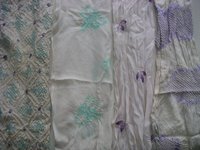
着物を生かすのは帯、そして帯を生かすのは帯揚げと帯〆です。こういう呼び名をどういう英語に移したらいいのか考えていたところに、先日ご紹介したリザ・ダルビーさんの本、「Kimono」が届きました。英語でキモノのすべてが説明してあって、強力な参考書になりそうです。因みに帯揚げ、帯〆は、オビ・スカーフとオビ・コードでした。

Obi-scarf(obi-age) is a scarf length rectangle thin silk. A small pillow would be wrapped at the center with the scarf. It makes a swell inside the taiko at the back like a bustle and both ends of obi-age are tied in the front and plunged into the gap at the top of obi.

Obi-code is tied at the center of obi. It is chosen to accent its color.

ところでつい最近になってようやく、例の「さゆり」のDVD をレンタルして観ました。何だか私は、
どうしてこれが”日本”なのかという疑問ばかりが先に立ち、ストーリーに感情移入ができませんでした。本当の京都らしい景色、本当の日本らしい着物姿がところどころにあるものの、中国風の髪型や家並や着物スタイルが色濃くミックスされていて、好きではありませんでした。ハリウッドは”日本らしさ”よりオリエンタルな雰囲気があれば充分なのですね。成田の空港のお土産店には外国人向けの、日本の雅とはほど遠い何とも不思議な着物が売られていますが、あんな感じがしました。日本の方、海外の方、両方の感想をお聞きしたいものです。
I have seen the DVD of "The Memoirs of a Geisha" recently. I couldn't concentlate the story because of very strange mixture of Japanese and Chinese culture on screen. Why they liked the mixture better than pure and real Japanese kimono style? I have seen many pseudo-kimonos for souvenior in Narita airport shops, which are far different from our real kimonos. Why tourists like them better than real ones? Do you have any opinion?
11 comments:
ようやく、落ち着いた気持ちで、新しいブログ先を訪問させてりただいています。すごいですねえ。えらいですねえ。日本の文化を少しでも、間違いなく伝えたい・・・。私も、同感です。あの映画は、違いすぎますよね。あの映画を製作するのに、日本人は関わっていなかったのでしょうか・・?たまらないくらい・・です。特に、中国とはまったく違うのだーーっていうことを、伝えたい。まだまだ、誤解されていますよね。
私もあまり見たくはなかったのですが、こんなブログをやっていますから、まずは見ようと思ったのです。案の定、予想どうりだったわけです。考証する気があれば日本人俳優も多数出ていますから、いくらでも真実に近づけることはできるはずなのに、意図的にああいう形にしてしまう理由がわかりません。映像的な受け狙いということなのでしょうか。そしてそれを見た外国の人たちがあれを”日本”だと誤解するとしたら、何とも不愉快な気分になります。でも目くじらを立てても仕方ないので、「急がば回れ」で、せめて日本に憧れているクレージーキルターの人たちには、このブログ上で本物を見せることで、多少はより正しい理解に近づいて欲しいと思うのです。個人レベルでできることに限界があるのはわかっているのですけれど。
私は桃井かおりさんとか結構昔から好きだったのですが、出演している俳優さんたちは、あれは結局ハリウッドの映画だからと割り切ってしまうのでしょうか。何だか釈然としません。
I doubt tourists know the difference! Thanks for this informative post. I didn't know what the names of the "belt" parts were.
Thank you to inform us about your traditions.
We, all the people from the west don't see the diffrance between Chinese and Japanese kimono's.
Both of them are the East for us.
I know it's not easy for you to see the difference. But "kimono" is a Japanese word for our own Japanese traditional clothes. If you use the word of "kimono", that means Japanese clothes, never Chinese. If we treat Cossack as Scandinavian, or Scottish kilt is worn in England in Asian films, you must feel uncomfortable.
Hello there, because we dont know the difference and arent surrounded or brought up with these images and beautiful garments we are just ignorant really! I suppose we only have films to learn from unless we choose to study more about them. You made me giggle about the Scottish kilt being worn by and English man!! As an English lass living in Scotland I dont know of many English men who would wear a kilt and if they did the Scottish would be thrilled to bits and very happy and proud.
I saw some Japanese kimono at an exhibition last year ~ they were very beautiful, elegant and simple and didnt look anything like the ones in the film! I think films should be taken lightly ~ not too seriously, afterall we had Mel Gibson play a Scotman!!! Take care hugs Jude xxx
Konnichiwa Hideko!
I am Australian and have just found your blog. I have always been interested in Japanese culture and have visited your beautiful country. I have been writing to a friend in Tokyo for 30 years and she has been here once. I also visit two Japanese ladies who were war brides and came here in about 1952, so I have learnt much about the Japanese culture and language. I have two genuine Kimonos and one Obi. I am enjoying reading your blog and will visit you again soon.
Sayonara from Gina in Melbourne Australia
Dear Hideko,
I am learning so much about your culture as i make my Japanese quilt.
Thank you for your comments on my blog, I am not very knowledgeable about your culture as i am learing as i go...so please correct me if I post something that is not right, and I hope you are so far happy with what I have done.
Judy, Gina and Julia,
Thank you very much for your comments to this rather emotional my writing. I feel a bit embarrased today I was too serious to have compared Japanese and Chinese. Maybe the movie made me a bit upset. I will write about our kimono culture again as the second series, though not now, but later.
Hideko, please don't feel embarrassed about what you wrote. I understand your emotions - there is a big difference between Japanese and Chinese culture, but it is not appreciated by most Westerners unless they take the time to learn more about both countries. I think Judy and Julia are both keen to learn!
Hideko
I have not been to you blog for such a long time and I a so sad that you are apologise for being emotional about something that is so what has come to be recognised as being your culture, I thought I knew a little bit of your culture and now looking back I can see the difference between the 2 there was a definite difference in the kimonos being worn. Yes I have watched it that many times and I am buying the DVD this week, and I will be looking to see if I am right- expect some emails Hideko.
please though never apologise for being strong about your culture nor about your command of the English language. You write very well and there's a lot of English who struggle with the language themselves. I am ready any time you want to take by the hand and explain the differences in your culture and any other on earth
my love n hugs always
Bear xoxoxoxo
Post a Comment